On a recent trip to the supermarket, shoppers entered the store and were immediately struck by an 8 foot high wall of red – bouquets of red roses setup in tiers, other flowers wrapped in red paper, hearts of all sizes and shapes, some as balloons, some filled with candy, others with chocolate covered strawberries.
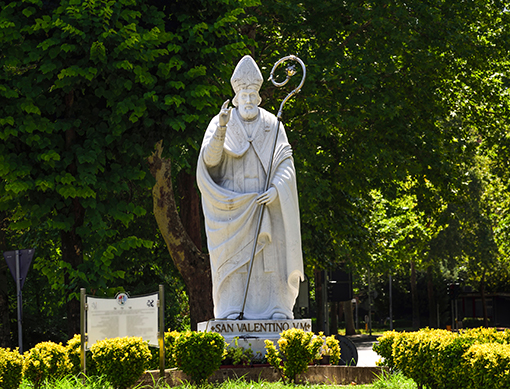 The display was wide enough to obscure the entire produce department. It was garish, it was overkill, it was the perfect demonstration of how a holiday with a lovely tradition and meaningful message has become commercialized.
The display was wide enough to obscure the entire produce department. It was garish, it was overkill, it was the perfect demonstration of how a holiday with a lovely tradition and meaningful message has become commercialized.
One shopper passing by the display shook her head and turned to me to say, “Just in case you forgot Tuesday is Valentine’s Day.” We both chuckled and walked away.
Valentine’s Day is a holiday with a storied history. Sometime along the way the “saint” was dropped from a day named after a venerated Catholic – St. Valentine.
Tradition holds that St. Valentine was Bishop (and patron saint) of Terni, Italy, ordained in 197. He was known as a man of great love and devotion to those in need, and because of his greater love for Christ, was blessed with working miracles and healing the sick. His love of Christ and his faith was so great that he refused to deny both to the Emperor of Rome and was sentenced to death.
He was martyred on Feb. 14.
While the Valentine’s Day we know and celebrate is focused mostly on romantic love, the love of St. Valentine is a more profound, life-changing love that comes from a relationship with God. In these challenging times, with bullying a sad reality for many children, and a culture that seems to be moving away from sacrificial love of others to selfishness and entitlement, the reinforcement for children that they are loved by God is essential. It’s is also essential that they learn to share that love, which has a foundation in a respect for life in general, in their everyday lives.
Without detracting from the lovely Valentine’s Day traditions established in our homes and classrooms, this special holiday is a wonderful opportunity to help bring a deeper meaning of love to the celebration.
Consider adding:
Sacred Heart of Jesus and Immaculate Heart of Mary – Among the many hearts displayed or used for Valentine’s Cards, include a visible reminder of the hearts of Jesus and Mary, from whom perfect love flowed. Such images, though Valentine’s Day is once a year, reminds students that love is needed and should be shared every day. See the reflection on the Sacred Heart of Jesus at the end of this post, and the short morning offering prayer to the Immaculate Heart of Mary that may be added to morning prayers in the classroom.
Use Scripture quotes as Valentines or conversation starters – Some examples: “So faith, hope, and love abide, these three; but the greatest of these is love” (1 Corinthians 13:13); “And above all these put on love, which binds everything together in perfect harmony” (Colossians 3:14); “Let love be genuine. Abhor what is evil; hold fast to what is good” (Romans 12:9).
Have a conversation about love – Use 1 Corinthians 13:4-8, a Scripture quote often read in marriage ceremonies. There are 16 qualities of love mentioned here, each of which is an opportunity for students, guided by teachers, to share their understanding of what each quality means. “Love is patient, love is kind. It does not envy, it does not boast, it is not proud. It does not dishonor others, it is not self-seeking, it is not easily angered, it keeps no record of wrongs. Love does not delight in evil but rejoices with the truth. It always protects, always trusts, always hopes, always perseveres. Love never fails.”
O Jesus, through the Immaculate Heart of Mary,
I offer you my prayers, works, joys, and sufferings of this day for all the intentions of your Sacred Heart in union with the Holy Sacrifice of the Mass throughout the world, for the salvation of souls, the reparation of sins, the reunion of all Christians, and in particular for the intentions of the Holy Father this month.
Amen.
For teachers: A reflection - God's Servant First: The Sacred Heart of Jesus - A Reign of Love | USCCB
 About the Author
About the AuthorMary Clifford Morrell, mother of six and grandmother to ten, is a Catholic journalist, editor, and author who has served the Dioceses of Metuchen and Trenton, New Jersey; Burlington, Vermont, and RENEW International in the areas of religious education and communication.
Though shrouded in the mists of time, St. Valentine’s legend tells of a 3rd Century bishop in Italy, who died a martyr’s death. The Roman leaders imprisoned him for secretly conducting marriages for soldiers, who were not allowed to have wives. He is said to have sent a letter – “from your Valentine” -- to his jailer’s daughter after he healed her of blindness. How appropriate that on his feast day we recall his courageous ministry to lovers and notes of loving care to friends.
 Tender Hearts. If you are planning a classroom card exchange, help everyone have a good time by requesting that children include everyone in the class on their list.
Tender Hearts. If you are planning a classroom card exchange, help everyone have a good time by requesting that children include everyone in the class on their list.
Decorate the doors or windows – Brainstorm with students about what they love about their friends, their school, their family, their parish. Have students cut out hearts and write some of these “loving thoughts” and display them in your classroom during February.
Chains of Love. Print Bible verses about love and friendship on red, white, and pink paper. Cut the verses into strips, fold each strip in half, bend into a heart shape, and join the strips into links of a chain. Each day after Valentine’s Day, tear off a heart and read the Scripture aloud in your classroom prayer time.
Top Bible Verses about Love: Use some of these to make the chains of love hearts, above, or have children print and decorate the verses on cards to share with family and friends.
• 1 Corinthians 16:14 - Let all that you do be done in love.
• Colossians 3:14 - And above all these, put on love, which binds everything together in perfect harmony.
• 1 Corinthians 13:13 - So now faith, hope, and love abide, these three; but the greatest of these is love.
• John 15:13 - Greater love has no one than this, that someone lay down his life for his friends.
• 1 Corinthians 13:4-7 - Love is patient and kind; love does not envy or boast; it is not arrogant or rude. It does not insist on its own way; it is not irritable or resentful; it does not rejoice at wrongdoing, but rejoices with the truth. Love bears all things, believes all things, hopes all things, endures all things. (Hint: You can get 11 mini-verses about love from this one verse!)
Images of Loving Care. Instruct students to search through their faith formation book to find three illustrations or photographs that show someone doing a loving action. Have them share their findings with the class in their own words. Who is showing love? How are they showing love? Who is receiving the love?
Hearts in Catholic Art. Although their official feast days are in June, the Sacred Heart of Jesus and the Immaculate Heart of Mary are also good ideas to share on Valentine’s Day. These traditional icons vividly depict the sacrificial and unconditional love of our Lord and his Blessed Mother for all of us. Explain that each of us is called to express such love for God and our neighbors.
 About the Author
About the AuthorDr. Lauri Przybysz specializes in equipping families to live their vocation to be domestic churches and signs of God’s love. Lauri received the Doctor of Ministry from the Catholic University of America, and she has been both a Catholic middle school religion teacher and a faith formation coordinator at the archdiocesan and parish levels. She is the mother of six children and grandmother of 21.
On the day that I graduate from college with my bachelor’s degree, my dad graduated from high school with his GED.
I don’t know who he was proudest of, me or himself.
 My dad was one of many who missed out on school during the Great Depression because they were forced to go to work to help support the family. For my dad, that happened when he was in eighth grade. His dad had died a few years earlier and all his brothers were much older and had moved out of the house. It was him and his mom and times were very tough.
My dad was one of many who missed out on school during the Great Depression because they were forced to go to work to help support the family. For my dad, that happened when he was in eighth grade. His dad had died a few years earlier and all his brothers were much older and had moved out of the house. It was him and his mom and times were very tough.
As I grew up, my dad, who was exceptionally intelligent and self-educated, often talked about the blessing of education and the gift of knowledge.
Fortunately, most of our children have not been deprived of either, but there are many across the country and around the world who are. I think we give our children a gift when we help them understand that our ability and opportunity to learn is a blessing that shouldn’t be taken for granted.
And surely, our ability to learn and to make wise choices with our knowledge is a gift from God. Scripture teaches us about the gift of knowledge and the value of learning. Psalm 18:15 reminds us, “The mind of the discerning acquires knowledge, and the ear of the wise seeks knowledge.”
Students will learn about the Seven Gifts of the Holy Spirit at some point during their religion classes, so they will learn that three of those gifts are Wisdom, Understanding and Knowledge. The tendency is often to memorize the list but never enter into any in-depth discussion about what the three are, how they are different from each other and how they are connected.
As Catholics, we believe in God as relational, being in a relationship with each of his children. To help us live in relationship with God and with our brothers and sisters God instills in us a need to learn, a need for wisdom to make good, godly judgements based on our understanding of the knowledge we have gained during our lifetimes.
How can we encourage our children and youth to value these gifts of God?
Provide opportunities for students to demonstrate something they have learned, whether it was in a class or on their own. Ask them to share the different ways in which they learn. Undoubtedly, they will talk about social media, but encourage them to think about reading, investigating with microscopes or telescopes, or what they’ve learned from adults who share their knowledge.
Share your knowledge with your studentsTeachers often get caught up in the lesson plan and forget that they own a wealth of knowledge on things outside of the class material. Enthusiasm about knowledge is contagious and makes teachers excellent role models for students. Do you garden, play chess, play an instrument, bake, do calligraphy, build models”? The list is endless, but each one of these specialties are more than just a hobby. They require a unique knowledge that can be shared.
Gather motivational stories about people whose lives were changed by knowledge. Fellow teachers or school staff may have stories to share or check with the school or local librarian for age-appropriate books. One story that comes to mind is that of Helen Keller, who lost both her sight and her hearing as a baby. She became a prolific author and the first deaf and blind person to earn a Bachelor of Arts degree. She said, “Knowledge is happiness, because to have knowledge – broad, deep knowledge – Is to know true ends from false, and lofty things from low.”
Helen also had a great love for God, who she said, “is very near each one of us.” Helen shared her feelings that “It is so pleasant to learn about new things. Every day I find how little I know, but I do not feel discouraged since God has given me an eternity in which to learn more.”
Ask questions on a regular basis. At the end of every day, ask a few students, “What’s one thing you learned today?” When students come back to school after the weekend, or a vacation, ask, “What did you learn while you were away?” The repetitive question encourages students’ understanding that learning new things can happen anywhere at any time, and is something worthy of sharing.
Talk about knowledge as a gift from God.Scripture is full of teaching about the source of wisdom, understanding and knowledge. Here are a few quotes:
- Proverbs 2:6 – For the Lord gives wisdom, from his mouth come knowledge and understanding.
- Isaiah 11:2 – The Spirit of the Lord will rest on him— the Spirit of wisdom and of understanding, the Spirit of counsel and of might, the Spirit of the knowledge and fear of the Lord.
- Psalms 119:66 – Teach me wisdom and knowledge, for in your commandments I trust.
For teacher reflection: "The gift of knowledge puts us in tune with God's gaze on things and on people. …Through this spiritual gift, we are enabled to see every person, and the world around us, in the light of God's loving plan." ~ Pope Francis
 About the Author
About the AuthorMary Clifford Morrell, mother of six and grandmother to ten, is a Catholic journalist, editor, and author who has served the Dioceses of Metuchen and Trenton, New Jersey; Burlington, Vermont, and RENEW International in the areas of religious education and communication.
After two years of not being able to gather together, it was a joy, this year, to attend a Lenten morning of recollection led by renowned artist Oblate of Saint Francis de Sales Brother Mickey McGrath. Brother Mickey took us through the Stations of the Cross, using his own inspired artwork, helping us connect the stations to our own experiences and what is happening in the world today.
 He also shared his outreach to youth, providing them with occasions to join him in creating art as part of their spiritual journey, opportunities the youth acknowledge as powerful learning experiences in faith.
He also shared his outreach to youth, providing them with occasions to join him in creating art as part of their spiritual journey, opportunities the youth acknowledge as powerful learning experiences in faith.
There are many ways in which children learn and come to faith. Among the most effective is engagement in the creative process, using their imaginations and their own experiences. This can be heightened by learning within a community, like the Catholic school classroom.
As we move through Lent and begin planning for Holy Week, there is a wealth of Catholic teaching, liturgies, devotions and celebrations that may be incorporated into a creative lesson that would lend itself to a mini-retreat in the classroom. Additional Activities and Enriching the Lesson sections from the Blest Are We teacher’s guides offer helpful ideas for engaging students, depending on their ages, in themes of forgiveness, charity, fasting and self-discipline, Stations of the Cross, Holy Thursday, especially as it relates to Mass, Good Friday, and Holy Saturday.
A Mini-Retreat
Begin and end with prayer: Refer to religion textbooks for appropriate prayers, or choose a favorite Psalm or prayer with which children are familiar.
Prepare music: A background of inspirational music is helpful in lending a prayerful element to the experience while children are working.
As Inspiration: Prepare a black or white board with words or symbols denoting Lenten practices, like forgiveness or charity, and invite students to add related words to fill the board, or if time is very limited, add additional words yourself. Students may use these words to portray their own understanding of a theme or topic in a chosen art form:
- God Letters – Children often feel like they are not being heard. Writing a letter to God gives them an opportunity to be honest before God about their joys, reasons for gratitude and their fears.
- Stained Glass “Windows” – These windows have an important history in the Church as a means of religious education for those who were not literate. The images enabled all the faithful to have a better understanding of the Gospel and the life of Christ. Have children draw a religious symbol or word of their choice (hearts included) in the center of drawing paper, outlining it in black and coloring; divide the rest of the page into random sections also outlined in black; color sections in bright colors.
- My Own Vespers – Vespers, or evening prayer, are part of the Liturgy of the Hours. They have been prayed for centuries, often by monks who prayed the Psalms of the Old Testament. It is helpful if children are familiar with the Psalms, but even if they are not, children may be encouraged to create their own evening prayer to be said before the end of every day.
- Poems of Faith – Among the saints of the Church are a good number of poets, including St. Thérèse of Lisieux and St. Hildegard of Bingen. Most classrooms also include a budding poet or two. Children who write poems may also want to illustrate the poems as meaningful for them.
Plan to display the work of children, if they are agreeable.
For additional ideas and information, visit RCL Benziger’s free, downloadable Lenten resources and Saints Resource.
 About the Author
About the AuthorMary Clifford Morrell, mother of six and grandmother to ten, is a Catholic journalist, editor, and author who has served the Dioceses of Metuchen and Trenton, New Jersey; Burlington, Vermont, and RENEW International in the areas of religious education and communication.
Product Highlight
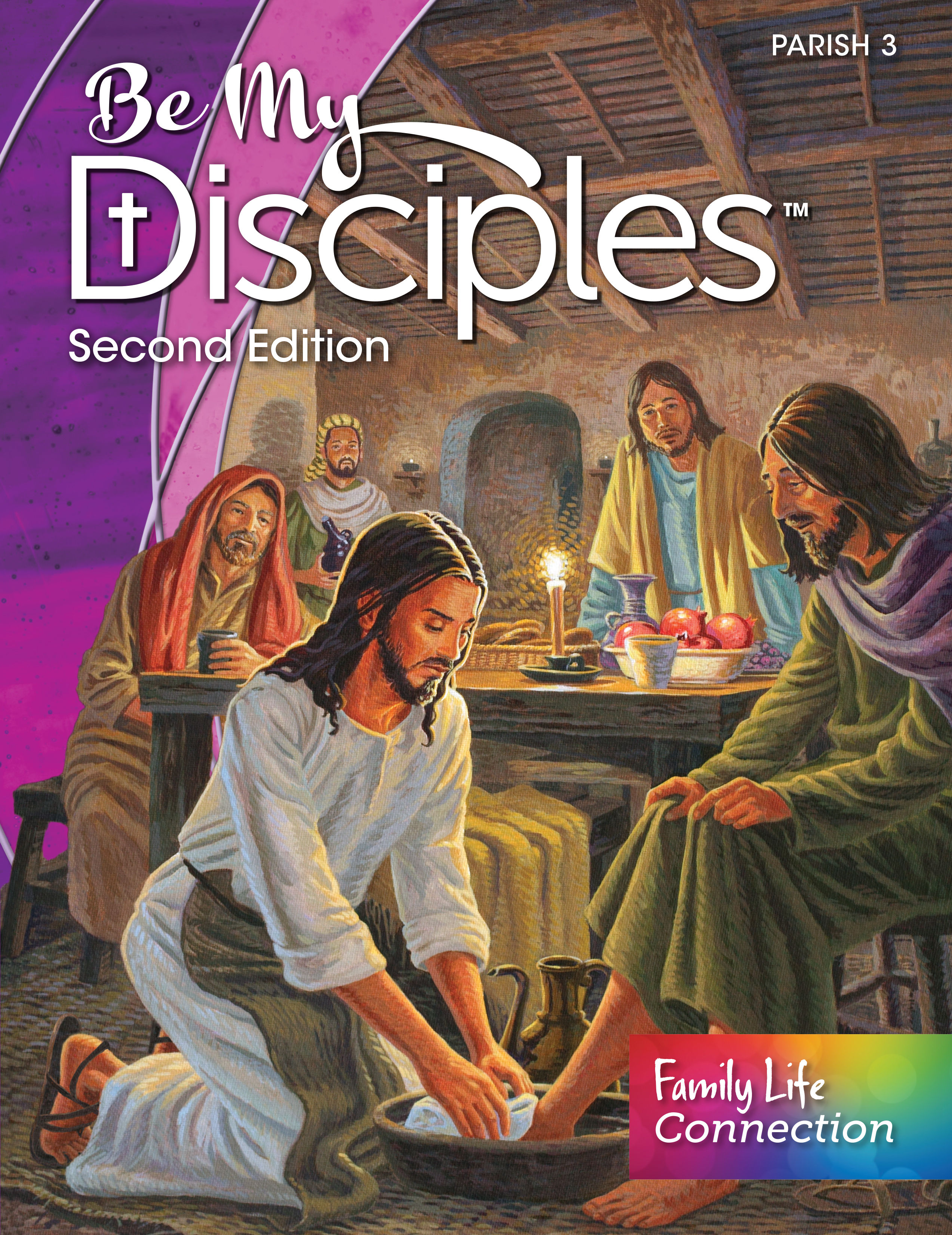 Be My Disciples Second Edition
Be My Disciples Second Edition
This new Parish Program for grades 1-6 now includes the Family Life Connection, an amazing family resource built right into the Student Edition textbook! Students will take home this two-page insert to help them build the skills they need to live healthy, holy lives. This newly updated and expanded edition encourages children to understand their role within the parish community and continue to grow in their identity as sons and daughters of God.
Jesus has taught us the perfect way to pray in the Lord’s Prayer, found in similar forms in the Gospels of Luke (Ch. 11) and Matthew (Ch. 6). The disciples could see that prayer was an important part of his life. They must have noticed something about the way he prayed that was different. It made them want to learn how to pray as he did. Luke tells us that Jesus was “full of joy through the Holy Spirit” when he prayed. (Luke 10:21a). Prayer refreshed and renewed him.
 Saint Augustine (A.D. 354-430) described the Lord’s Prayer this way: “Run through the words of the holy prayers [in Scripture], and I do not think that you will find anything in them that is not contained in the Lord’s Prayer.” We pray this prayer at every Mass. It is the tradition of the Church to pray the Lord’s Prayer three times a day. Think about when you could add the Lord’s Prayer one extra time during the school day with your students.
Saint Augustine (A.D. 354-430) described the Lord’s Prayer this way: “Run through the words of the holy prayers [in Scripture], and I do not think that you will find anything in them that is not contained in the Lord’s Prayer.” We pray this prayer at every Mass. It is the tradition of the Church to pray the Lord’s Prayer three times a day. Think about when you could add the Lord’s Prayer one extra time during the school day with your students.
The Lord’s Prayer illustrates the order in which we should pray: Praise; Petition; Sorrow; Reliance of God totally. If we do this, our relationship with God will be in right order and so will your priorities. Your Blest Are We Faith in Action revisits the Lord’s prayer in every grade. Look in the Table of Contents in your Teacher Edition for more ways to teach and pray the Lord’s Prayer.
We Examine Our Actions. Reflecting on the Lord’s Prayer is especially appropriate when your students are preparing to go to Confession. It has all the various kinds of prayer in one: God’s name is glorified, his plans for creation be fulfilled, we realize how God cares for us and gives us what we need, our daily bread and forgiveness of our sins. We pledge to forgive others, confident that God will defend us from harm.
From Trespasses to Treats. After praying the Lord’s Prayer, ask students to name some ways that someone might trespass against another person. After making a list of their ideas, ask students for ways they would want to be treated instead. For example: A trespass could be excluding someone from a game; the treat could be to invite them to play. Another example, a gossiping about someone is a trespass; it would be a treat to say what you like about the person.
Putting Prayer in Motion. We can pray with our bodies as well as our voices. For example, we genuflect silently to offer God praise. We make a Sign of the Cross. Invite students to act out the Lord’s Prayer. Ask students, “If you wanted to pray the Our Father without using words, how would you dramatize “heaven,” “daily bread,” "forgiving,” or “deliver us”? You could even add music to the prayer demonstration.
Explore more ideas for classroom prayer in the free Catholic Resources.
Product highlights:
- Catholic Prayers and Practices for Young Disciples (English)
- Catholic Prayers and Practices (English)
- Our Family Prays - Catholic Prayers & Traditions (English)
 About the Author
About the AuthorDr. Lauri Przybysz specializes in equipping families to live their vocation to be domestic churches and signs of God’s love. Lauri received the Doctor of Ministry from the Catholic University of America, and she has been both a Catholic middle school religion teacher and a faith formation coordinator at the archdiocesan and parish levels. She is the mother of six children and grandmother of 21.
My spiritual life was deeply affected by a gentleman at my parish, someone I didn't know and who undoubtedly didn't know me. When I did see him, he was going to Confession or to pray before the Blessed Sacrament, something he did weekly. One day I realized he was pulling an oxygen tank behind him. Over the course of time, he started to use a walker and, eventually, a motorized scooter, all the time taking the oxygen tank with him.
 His devotion was obvious, as was his love for God. I began to pray for him daily and for myself, as well, that I would love God with the same commitment. What I discovered is that love manifests itself in different ways, all of which are divine qualities of God.
His devotion was obvious, as was his love for God. I began to pray for him daily and for myself, as well, that I would love God with the same commitment. What I discovered is that love manifests itself in different ways, all of which are divine qualities of God.
Our Catholic faith teaches, "God is love," but I think we sometimes gloss over that truth and focus on other elements of our faith, like prayer and doctrine, Sacraments, and devotions, because they are more concrete. Love is abstract. What exactly does love, particularly God's love, mean?
For Christians, it would be better to ask, "What does it require?" To have a better understanding of the answer to that question, we must work toward understanding God's love and helping our children understand it as well.
Pope Francis has stressed that God's love is not easy to understand. "It is a love that cannot be understood. A love that surpasses all knowledge. It surpasses everything. The love of God is so great; a poet described it as a 'bottomless sea without shores…' This is the love that we must try to understand, the love that we receive."
The Holy Father explains that God loved us first by calling us into being and then loved us so much he chose to become one of us for our salvation so we could learn more about who God is and how God loves. Jesus became our teacher through his life and his death.
"This is the mystery of God's love: the greatest greatness expressed in the smallest smallness. This allows us to understand Christianity. Jesus teaches us the kind of attitude a Christian should have; it is all about carrying on God's own work in your own small way … Works of mercy, pave the path of love that Jesus teaches us in continuity with God's great love for us!" said Pope Francis.
Looking to Scripture (1 Corinthians 13:1-8 is a good start), we can learn what love is and what it is not based on the way Jesus loved. Children can begin to learn how God's love, perfect love, can inform and serve as a model for human love, which is rarely perfect.
Love is healing – While we may not be healers in the sense that Jesus healed, as adults, we know that a loving presence can help in the emotional and physical healing of someone who is sick, grieving, or simply lonely. Ask children what they might do for a sick friend or classmate or a classmate who sits alone in school.
Love is forgiving – Everyone makes mistakes, some more serious than others. Jesus makes it clear that forgiveness is part of love, instructing Peter to offer forgiveness "70 times seven," a number meant to symbolize something too big to count. Ask students to share their forgiveness experiences or to share why forgiveness is often so difficult (no wrong answers here).
Love is patient – Patience is a hallmark of enduring love, love for the long-haul. It's also a challenge, especially when the person you love does something thoughtless or hurtful, making it very difficult for those who vow "for better or for worse." Patience is also a tough one for children. Discuss the meaning of patience with your students and ask for examples of patience, or not, in their own lives. If they have siblings, there should be plenty of input.
Love is kind – In his letter to the Ephesian community, Paul writes, in a section entitled Rules for a New Life (Ephesians 4:25-32), "… be kind to one another, compassionate, forgiving one another as God has forgiven you in Christ." Kids do know kindness, what it means for someone to be kind to them and what it means to be kind to others, especially their pets. Let them share their kind moments and applaud them for their goodness.
There are many other aspects that could serve as discussion points – humility, trust, self-sacrifice, and, I'm sure, an interesting list created by students.
For teacher reflection, also from Paul to the Ephesians,
"… living the truth in love, we should grow in every way into him who is the head, Christ, from whom the whole body, joined and held together by every supporting ligament, with the proper functioning of each part, brings about the body's growth and builds itself up in love" (Ephesians 4:15-16).
 About the Author
About the AuthorMary Clifford Morrell, mother of six and grandmother to ten, is a Catholic journalist, editor, and author who has served the Dioceses of Metuchen and Trenton, New Jersey; Burlington, Vermont, and RENEW International in the areas of religious education and communication.
Product Highlight
Family Life Second Edition
Family Life Second Edition is the newly updated edition of RCL Benziger's leading K-8 supplemental program that addresses key concerns of today's Catholic families. Family Life includes child safety education in every grade level, promotes virtuous living, and strengthens Catholic identity.
The Family Life program reinforces the Catholic virtues and values that your students attain with their education. Family Life is essential to your school-based religious education program and meets Social and Emotional Learning (SEL) standards and benchmarks.
The last time I remember feeling a deep sense of belonging was during a retreat for Catholic school educators. My role was as diocesan staff, and while I had facilitated a number of retreats over the years, and was sometimes sought out for spiritual talks, this time, I was grateful to simply be in attendance, to listen and learn. Surprisingly, the real inspiration that day came from seagulls.
 Behind the retreat center, an enormous jetty of black rocks jutted out into the water, calling me to sit and just be for a while during the break. To get there, I had to cross a stretch of beach where a hundred or more seagulls were resting. There was barely room to put my foot down without stepping on one.
Behind the retreat center, an enormous jetty of black rocks jutted out into the water, calling me to sit and just be for a while during the break. To get there, I had to cross a stretch of beach where a hundred or more seagulls were resting. There was barely room to put my foot down without stepping on one.
I don’t remember how long it took to cross the beach, it was slow going, but during that time, not one seagull moved or flew away at what I believed to be my intrusion. It was an incredible experience of peace of mind and heart because I didn’t feel like an interloper or an outsider in the natural world. The gulls accepted me. I belonged.
Essentially, we all belong to God, our creator, but often times we need the reminder – as do our children. As one child care center proposes, “Every child deserves to have someone's eyes light up when they enter the room.”
Hopefully, children develop that profound sense of belonging within their families, but it needs to be supported and experienced within their school communities, as well. A wonderful “belonging” story to share in the religion classroom is the story of Zacchaeus, a tax collector, a sinner who was most likely not on the invite list for many gatherings or celebrations; a short little man who climbed a sycamore tree to catch sight of Jesus (Luke 19:1-10).
But Jesus knew Zacchaeus deep down and did what no one else would do. Jesus invited him to share a meal. He also invited himself to Zacchaeus’ house, making him a “guest of a man who is a sinner,” which shocked the locals.
Jesus let Zacchaeus know that he was loved, that he had value, and that he belonged, and the encounter transformed Zacchaeus, who “received (Jesus) with joy,” and ultimately became the person God had intended him to be. That is the fruit of belonging.
With today’s prevalence of social media, once children begin to connect and spend extraordinary amounts of time on tablets, video games, or phones, they often end up looking for belonging in all the wrong places.
On the road to helping our children develop a healthy sense of belonging in all the right places:
Share more Scripture stories – Jesus was known for bringing everyone into the fold, treating them with respect, and honoring their inherent dignity. Good Scripture stories, presented age-appropriately, include the Samaritan woman at the well (John 4:1-42), the pardon of the sinful woman (Luke 7:36-50); Nicodemus the Pharisee (John 3:1-8); the parable of the lost sheep (Luke 15:1-32).
Highlight unique abilities and strengths – Provide students with opportunities to demonstrate some area of strength or talent and encourage students to applaud and value the gifts of their classmates. Perhaps more important is recognizing what a student is really interested in, which may not be the same as a strength or ability. Interest is often a greater motivator than skill.
Follow Jesus’ example – Jesus the Master Teacher was an inviter and a listener, two practices that will help nurture students’ sense of belonging, and help them to become inviters and listeners themselves. Students might be encouraged to extend or accept an invitation to eat lunch or share recess time with another student or listen quietly and attentively while another student is speaking in class. Listening to others ensures we come to know them better and have some understanding of their wants and needs – a crucial social skill for children, who will become adults, and who have to share the playground.
See your classroom as a small faith community – Belonging to a faith community is a powerful way to grow in faith, feel welcomed and secure, and share a mission with other members. Students have that experience in their Catholic schools, and particularly, in their religion classrooms. Here they learn the faith, have opportunities for prayer and reflection, and give life to their faith through action. They may also worship together and celebrate sacraments together. A faith community is a powerful tool for belonging and an antidote to the challenges of today’s culture.
 About the Author
About the AuthorMary Clifford Morrell, mother of six and grandmother to ten, is a Catholic journalist, editor, and author who has served the Dioceses of Metuchen and Trenton, New Jersey; Burlington, Vermont, and RENEW International in the areas of religious education and communication.
Product Highlight
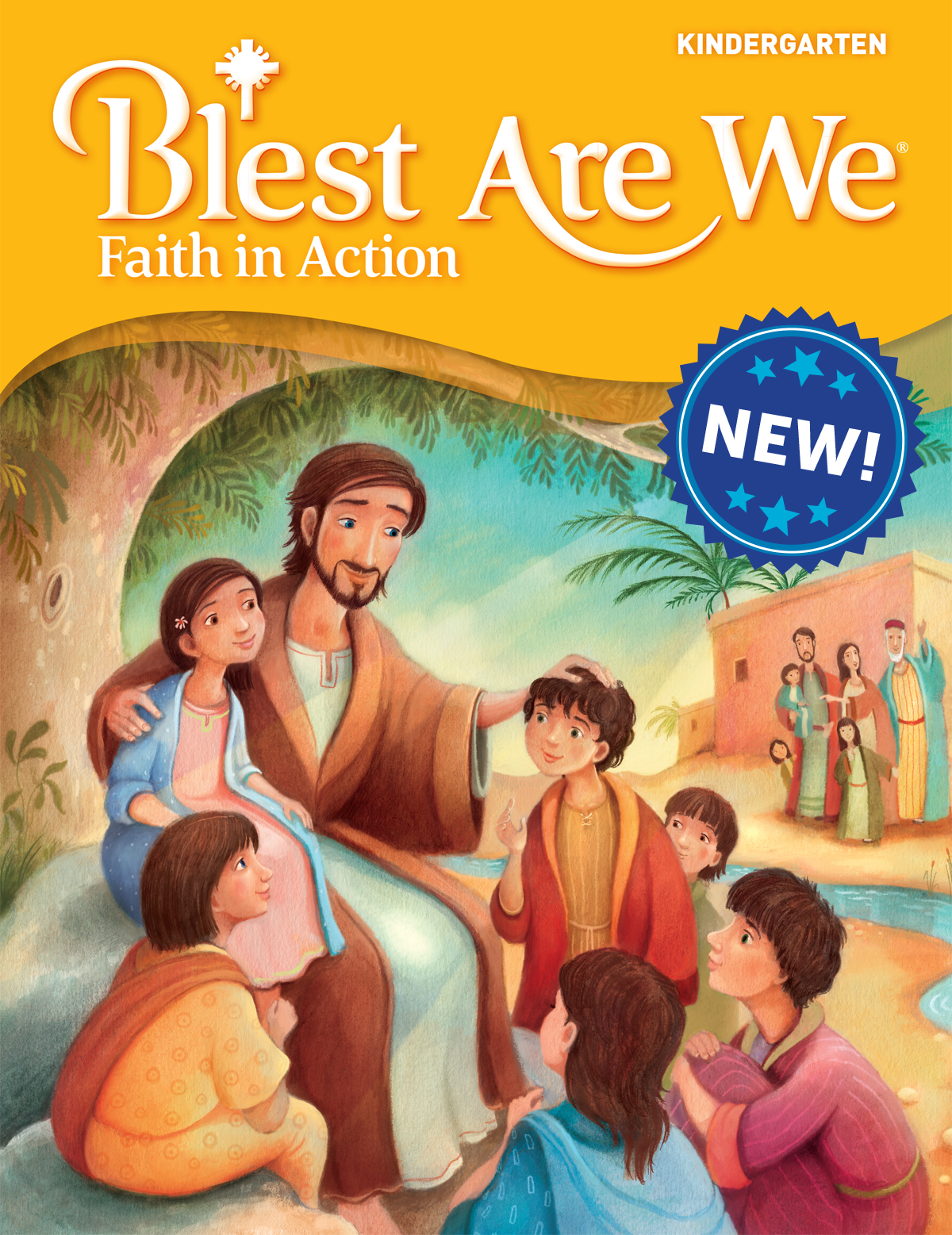 Blest Are We Faith in Action for School
Blest Are We Faith in Action for School
Blest Are We Faith in Action offers:
- Faith in Action pages for each chapter, establishing a strong connection to Catholic Social Teaching
- Redesigned Take Home pages, supporting families in the faith formation of their children
- Increased focus on children with special learning needs, addressing practical ways to adapt lessons
- Training Videos for Teachers, eBooks, eAssessments, Family Resources, Catholic Resources, Saints Resources, Lectionary Resources, and more!
New for the Blest Are We Faith in Action Series – Scripture Videos for Grades 1-8!
Enjoy a selection of 40 Biblical scripture story videos that accompany the student lesson pages in our Blest Are We Faith in Action series. These Catholic Bible stories, saint stories, and parables of Jesus enhance the Catholic Faith lessons in your classroom. There are five unique scripture videos for students in grades 1-8.
Hanging on the wall of my local Christian book and gift store is a poster entitled, “And He Shall Be Called.” It’s a simple poster comprised solely of the various names or titles referring to Christ found in the Bible. Below each name, in very small print, is the scripture reference that includes the name.
 Given its simplicity and lack of artistic images, its notable that in the 20 years since it was first printed, it has sold nearly 1.5 million copies. That speaks, I think, to the power of names.
Given its simplicity and lack of artistic images, its notable that in the 20 years since it was first printed, it has sold nearly 1.5 million copies. That speaks, I think, to the power of names.
Scripture reminds us, “The name of the Lord is a strong tower; the just run to it and are safe.”
In ancient times, names tended to have more meaning when it came to the character of the person named, which is why God or Jesus Christ often changed the name of someone chosen to be something more, someone for whom there would be a new path in life. Perhaps the most memorable is the disciple Simon whose name meant “one who hears or listens.”
When Simon was brought to Jesus, the Lord told him, “You are Simon the son of John. You shall be called Cephas” (Peter). Simon had no idea why his name would be changed, but Jesus knew that Peter, whose new name meant “rock,” was the one upon whom Jesus would build his church. Simon most likely had no idea he had that kind of leadership or strength in him.
The same is true for our children, especially as they become teenagers and are carrying heavy baggage we may not know about or understand. They may not be aware of the many gifts, God-given gifts, or talents they have. By valuing and respecting their names, we start our relationship with them by giving them the opportunity to value and respect who they are, with all their potential and not just all their mistakes.
What are the fruits of learning and remembering student names?
Building community – Learning student names is the first step in the process of getting to know them and ensuring that they feel like they are an important part of a community. Using student names, and saying them correctly, builds connection and a sense for students that they are being seen and heard. Experts in the field also observed that using a child’s name when speaking to them helps encourage positive behavior.
Seeing Every Child – Many years ago, at the request of a Catholic school teacher, I wrote a story that included every student in her elementary classroom by name. I designed the story into a small booklet and printed enough so every student in the classroom would have one. The class had students of many different nationalities, so many of their names were unique and, for some, challenging to read and pronounce. This short story made sure that each of them felt a part of the classroom community. How might you make sure every name counts?
Nurturing respect – Respect is an important Christian value, not only the respect of others but, as importantly, self-respect. A child’s name is crucial to their identity as a person and member of a family. By remembering their names and using them as often as possible, especially if we can look at them eye-to-eye at their level, we reinforce to students that they are worthy of our love and respect.
Growing student rapport – For each student, learning other students' names is important to building respect, rapport, trust, and accountability between students. Part of the process is learning how to say names correctly. It becomes easier the more often names are said aloud in class. All teachers have their own ways of memorizing student names, which might include desk name tags. These are not only valuable for teachers, but for younger students, it helps them develop a sense that their desk is their own personal space.
 About the Author
About the AuthorMary Clifford Morrell, mother of six and grandmother to ten, is a Catholic journalist, editor, and author who has served the Dioceses of Metuchen and Trenton, New Jersey; Burlington, Vermont, and RENEW International in the areas of religious education and communication.
Product Highlight
Stories of God's Love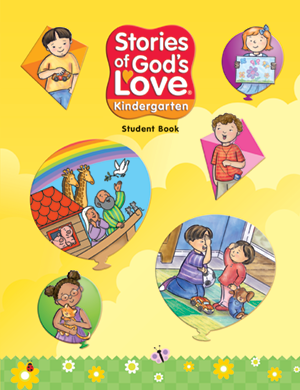
This program for preschool (ages 3-4 or 4-5) and kindergarten is an easy-to-use, developmentally appropriate early childhood curriculum designed to engage children and their families in learning about their Catholic faith and in making the connections between Scripture and daily life. Designed as the foundational cornerstone for each of RCL Benziger’s basal programs; Stories of God’s Love is aligned, connected, and integrated in a way that provides for the optimum sequential growth in a child’s faith formation. In addition, the program provides the flexibility needed to customize your school faith formation program.
Connecting with children’s social and emotional needs, the hands-on activities embedded within the curriculum are age and developmentally appropriate. Paired with the colorful illustrations, they engage the child and their family in creating a learning environment that mirrors God’s love for his children.
This morning I read a thought-provoking blog from a well-known deacon in the Church who wrote about the challenges of Church and culture and the interwoven nature of the two. He stressed that one of the reasons he was writing on this topic was because “the younger generation is watching.”
That’s a scary prospect, when we consider what children are exposed to today and what becomes assimilated as acceptable behavior, and while we may understand it as behavior unworthy of our Catholic faith, our children are still in the process of “becoming,” and need effort invested on all sides in their moral and faith formation.
That’s why the teaching of Catholic virtues is important in the religious education classroom. Virtues are described in the Catechism of the Catholic Church as “a habitual and firm disposition to do good. It allows the person not only to perform good acts but to give the best of himself” (CCC, no. 1803).
Catholic teaching identifies seven virtues, including three theological virtues which serve as the foundation for four Cardinal virtues. The three theological virtues are faith, hope, and love (charity), and “the greatest of these is love.” They relate directly to God and are gifts of God we receive in Baptism. The four Cardinal virtues, which are considered human virtues, are prudence, justice, fortitude, and temperance.
The language used in Catholic teaching to explain the virtues and their relationship to each other is sometimes daunting, such as in the Catechism of the Catholic Church, or writings of the Holy Fathers, but is worth tackling to help us, as religious educators, develop a fuller understanding of the simpler explanations in student texts. A greater understanding can only help us to be more effective in teaching students about the importance of virtues.
I have found the United States Catholic Catechism for Adults to be very helpful. It is an adaption of the Catechism of the Catholic Church developed by the United States Conference of Catholic Bishops. It relates Church teaching, as far as possible, to United States culture, affirming the positive elements and challenging the negative. Each chapter begins with a story of an American saint or other outstanding Catholic who belongs to a community of witnesses to the Catholic way of life, and also includes questions for discussion, meditation, and prayer.
The USCCA points out, “From the earliest days of the Church when St. Athanasius wrote the life of St. Anthony of the Desert, it was clear that telling stories about saints and holy people encourages others to be like them and is an effective way of teaching Catholic doctrine.”
That’s something easily done in a religion classroom and fits right in with one of the principal marketing practices for video games – community building. Let’s face it, given youth’s fascination with video games and anything screen-related, we are up against a formidable source of influence. We could take some lessons from their best practices for getting kids hooked.
In addition to the lessons in teacher guides, how may we cultivate Catholic virtues in the classroom?
Build Community – If sharing the lives of holy women and men with students provides them with models to emulate, evaluate how often you can manage it in the classroom. Additionally, these stories offer a consistent reminder that they, even as youth, are part of the communion of saints, comprised of all the members of the Church through all time including those now in the Church or those who have died and are either in Heaven or Purgatory. Remind students, visually as well as with words, that they belong to the family of God.
Create Saint Teams – As time and lesson plans allow, group students into teams under the name of a saint, maybe saints of a particular month or season. If old enough, have students work together to learn about their saint, discover the saint’s virtues and create a presentation on those virtues to share with the class. For younger students, use reading groups to read the story of a saint to the group and allow them to draw pictures about what they’ve heard and then talk as a group of the saint’s virtues.
Visual Displays – Tapping into the reality that children are inundated with and attuned to visual communication, consider using the language and definition of virtues as they are presented in the student texts to create single-word posters to keep on display in the classroom, or have students create symbols to represent each of the virtues, keep them on display, or turn them into class books.
Pray for Virtues – Add to your classroom prayers an opportunity for students to ask God for an increase in the seven Catholic virtues, or additional human virtues such as patience, humility, mercy, and kindness. Asking God for help is an excellent practice to cultivate in students, helping to develop the virtue of humility and faith for their journey ahead.
 About the Author
About the AuthorMary Clifford Morrell, mother of six and grandmother to ten, is a Catholic journalist, editor, and author who has served the Dioceses of Metuchen and Trenton, New Jersey; Burlington, Vermont, and RENEW International in the areas of religious education and communication.
Product Highlight
Family Life Second Edition
This program is the newly updated edition of RCL Benziger’s leading K-8 supplemental program that addresses key concerns of today’s Catholic families. Family Life includes child safety education in every grade level, promotes virtuous living, and strengthens Catholic identity.
The Family Life program reinforces the Catholic virtues and values that your students attain with their education. Family Life is an essential component of your school-based religious education program and meets Social and Emotional Learning (SEL) standards and benchmarks.
In light of the second annual World Day for Grandparents and the Elderly, established by Pope Francis in 2021 and observed on the third Sunday of July, I was asked to write an article on the unique experience of senior grief. I interviewed a psychologist and family counselor who serves in a grief support program, and a number of parish bereavement and consolation coordinators.
Across the board, they identified loneliness as the most prevalent problem for seniors, and interestingly, not only following the loss of a loved one. Older family members, neighbors, or friends are often hampered in their ability to get from place to place. Many no longer drive, and those who do are often much more fearful of driving than when they were younger.
 In my family, I have one aunt left, my mother’s sister. She has lost all four of her siblings, her husband, a late-in-life male companion, most of the extended family of her generation, and a daughter – one of her five children. We recently lost my cousin, her niece, and my aunt was inconsolable at the wake. “I’m so tired of burying my family,” she cried. “I’ve lost so many, and I miss them so much.”
In my family, I have one aunt left, my mother’s sister. She has lost all four of her siblings, her husband, a late-in-life male companion, most of the extended family of her generation, and a daughter – one of her five children. We recently lost my cousin, her niece, and my aunt was inconsolable at the wake. “I’m so tired of burying my family,” she cried. “I’ve lost so many, and I miss them so much.”
As their spouses, friends and children die, seniors are left more and more alone and often cut off socially, unable to visit friends, join others for shopping or make it to Mass or parish programs. They become all the more aware of their own mortality. It can be frightening.
The psychologist shared what she considered to be the most important gift we can give our seniors – to “provide support in the form of a listening ear and offer of ongoing social connection. Like anyone grieving, the elderly want to feel seen and heard.”
Bereavement ministries also mentioned the problem for many seniors of not being tech savvy. It often prevents them from staying on top of important responsibilities and programs, like banking, social security, Medicare, health insurance, or simply having the opportunity to connect with grandchildren in a way grandchildren respond to – like texting.
In the remaining days of summer, before school takes off like a roller coaster, consider sharing your time and talent with the elders of your communities. Take a senior to lunch, provide that listening ear, or teach them to text or become familiar with a computer. Or take your children with you and let them do the tech teaching!
It doesn’t take a lot to help older members of our families, parishes, or neighborhoods know they are seen and heard, and loved. A cup of tea, help around the house, a heat-and-eat meal or two, a box of their favorite treats, and an opportunity to share them with you.
It’s also a commandment to “honor your mother and father,” which would necessarily include grandparents and, hopefully, those of advancing years.
Pope Francis asks us to “Please, cherish the elderly!” It’s a beautiful lesson for our children and our students to learn, as well.
What can we do now, as well as during the school year, to honor seniors and help them fight loneliness?
Call them. A phone call is much more personal than a text and preferred by most seniors. For those who live alone, hearing another’s voice at the end of the line is a gift and helps them feel more at ease knowing someone is checking in with them. “I’ve fallen and can’t get up!” is not just a commercial.
Write them. There is something very special about receiving a letter in the mail. Seniors who are still capable are often happy to write back and share their stories. When a line of communication begins, it gives seniors something to look forward to and is often a bright spot in their day. Senior residential centers often have pen pal programs in place. You might want to check with one in your area and consider having students write to residents during the year, as well.
Go for a walk. Getting some sun and fresh air does wonders for the body. How and where you walk will be dependent on your senior’s physical condition, but even a short walk on level ground is something for them to look forward to. If walking is out of the question, a game of cards outdoors, engaging in a hobby, or putting together a puzzle on the porch in nice weather is a healthy choice for both of you.
Say the Rosary together. If praying a Rosary is an important devotion for your senior, it will have even more meaning shared with you. Or pick a Mass which has the recitation of the Rosary following and go together. Coffee and a donut on the way home sound good, too.
The value of being present to our elders is not in an elaborate plan but in the simple day-to-day activities they may be missing now because they are alone or their physical or mental state has changed. At the heart of it all is a desire for company and the knowledge that someone cares about them.
 About the Author
About the AuthorMary Regina Clifford Morrell, mother of six and grandmother to nine, is a Catholic journalist, author, and syndicated columnist who has served the dioceses of Metuchen and Trenton, New Jersey, and RENEW International in the areas of catechesis and communication.
Product Highlight
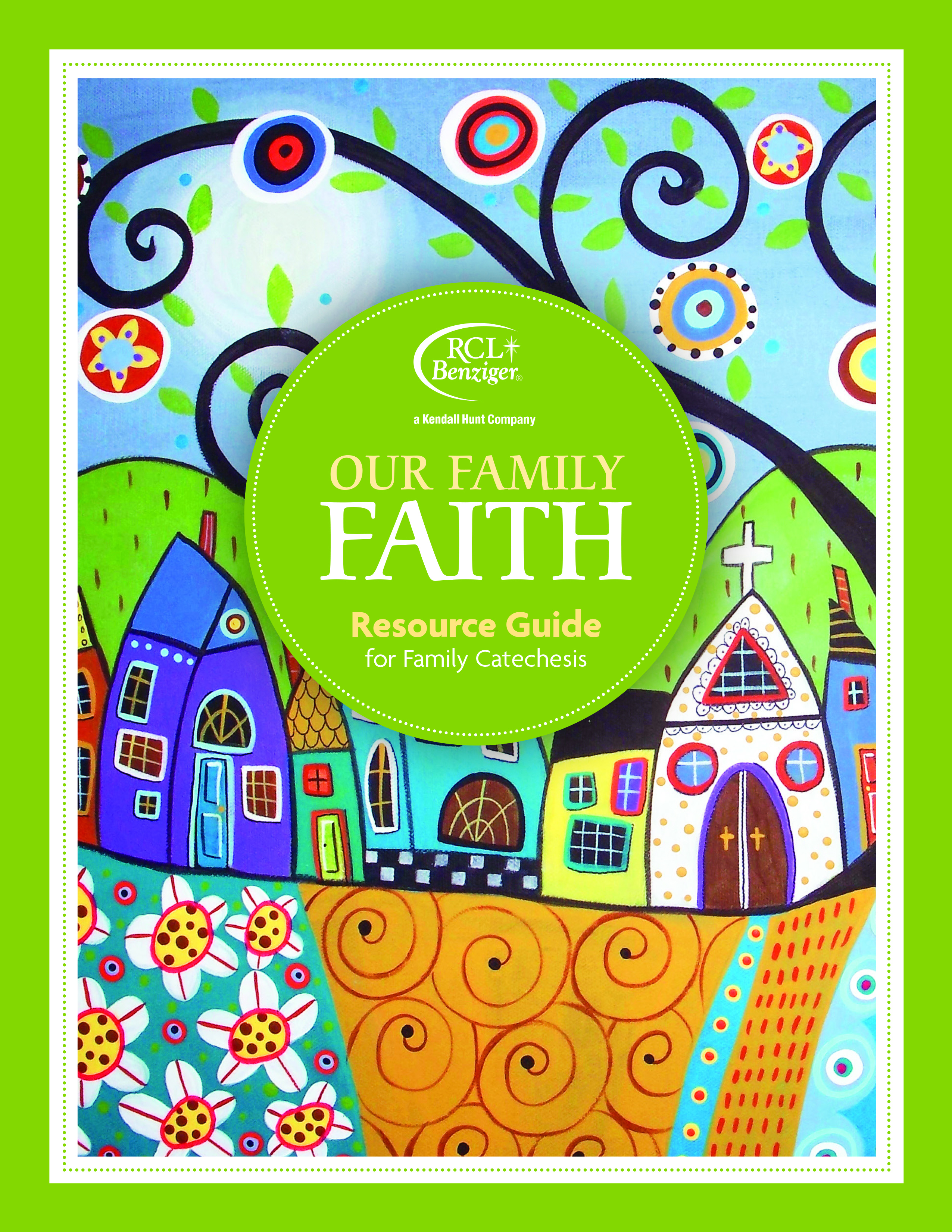 Our Family Faith
Our Family Faith
We listened when catechetical leaders asked for faith formation models that better engage families and support parents as the primary catechists of their children. We recognized the need for flexible and customizable resources that are simple, affordable, and effective.
Pagination
Latest
Categories
Archives
- February 2015 (2)
- March 2015 (2)
- April 2015 (5)
- May 2015 (3)
- June 2015 (6)
- July 2015 (3)
- August 2015 (5)
- September 2015 (5)
- October 2015 (4)
- November 2015 (2)
- December 2015 (1)
- February 2016 (2)
- March 2016 (1)
- April 2016 (2)
- May 2016 (2)
- July 2016 (2)
- August 2016 (2)
- September 2016 (1)
- October 2016 (5)
- November 2016 (1)
- December 2016 (3)
- January 2017 (2)
- February 2017 (3)
- March 2017 (2)
- April 2017 (1)
- June 2017 (2)
- July 2017 (2)
- August 2017 (1)
- April 2018 (1)
- October 2018 (2)
- December 2018 (2)
- February 2019 (3)
- March 2019 (2)
- April 2019 (2)
- May 2019 (3)
- June 2019 (1)
- July 2019 (16)
- August 2019 (8)
- March 2020 (4)
- April 2020 (6)
- May 2020 (8)
- June 2020 (7)
- July 2020 (5)
- August 2020 (7)
- September 2020 (4)
- October 2020 (5)
- November 2020 (9)
- December 2020 (11)
- January 2021 (10)
- February 2021 (8)
- March 2021 (5)
- April 2021 (4)
- May 2021 (4)
- June 2021 (5)
- July 2021 (2)
- August 2021 (3)
- September 2021 (4)
- October 2021 (4)
- November 2021 (2)
- December 2021 (5)
- January 2022 (4)
- February 2022 (4)
- March 2022 (9)
- April 2022 (7)
- May 2022 (9)
- June 2022 (12)
- July 2022 (7)
- August 2022 (10)
- September 2022 (9)
- October 2022 (11)
- November 2022 (8)
- December 2022 (7)
- January 2023 (2)
- February 2023 (10)
- March 2023 (9)
- April 2023 (10)
- May 2023 (8)
- June 2023 (4)
- July 2023 (3)
- August 2023 (2)
